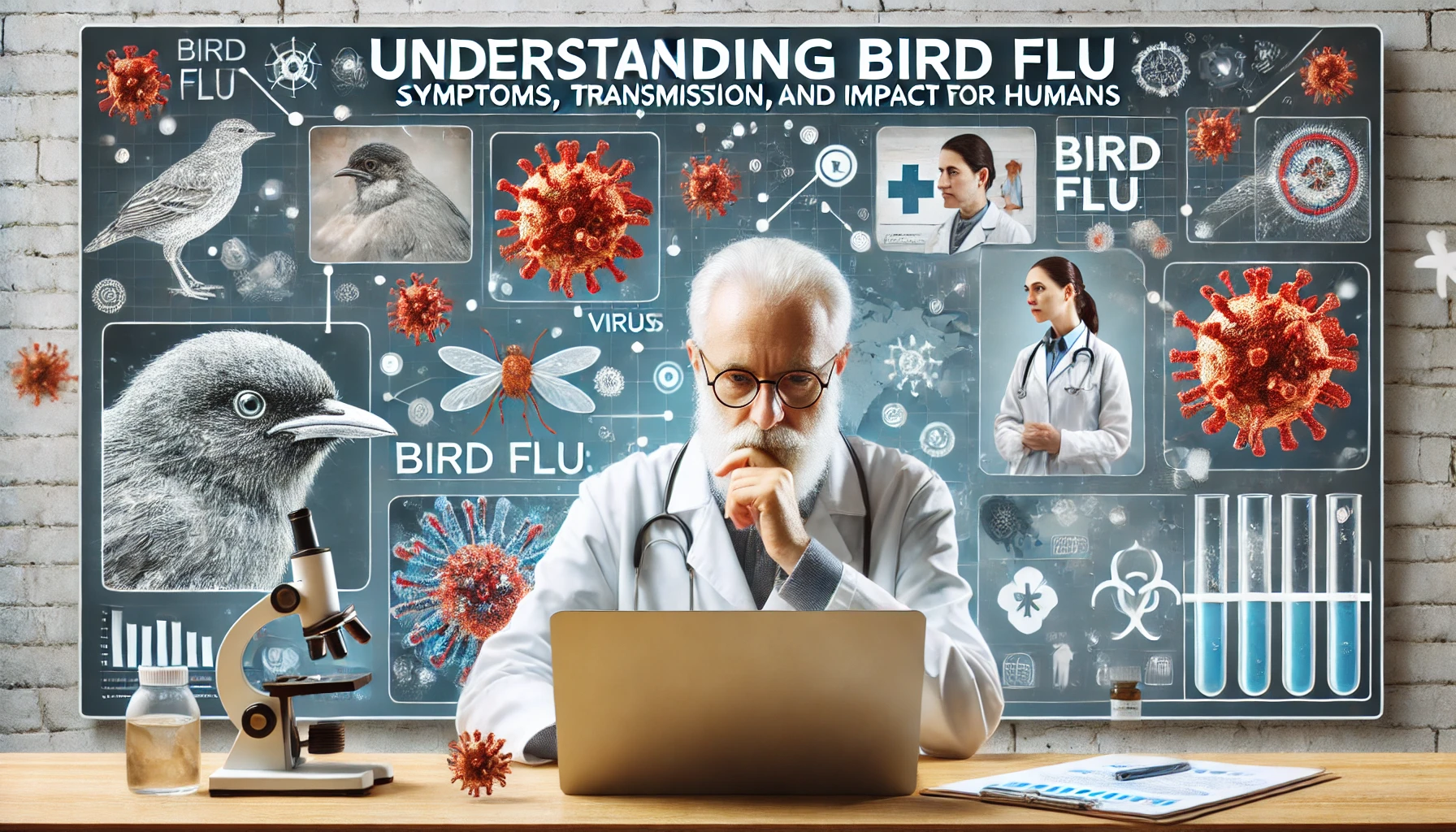Bird Flu: Symptoms, Transmission, and Impact on Humans
- Posted by Afnan Zeeshan (Kazakhstan)
- Categories Health
- Date July 24, 2024
Bird flu, also known as avian influenza, has raised significant concerns globally due to its potential to cause serious illness in humans. Understanding its symptoms, transmission methods, and impact on humans is crucial for both prevention and treatment. This comprehensive guide will delve into everything you need to know about bird flu, its symptoms, how it spreads, and its implications for human health.
Bird Flu Symptoms
Bird flu symptoms can range from mild to severe and are often similar to those of other flu viruses. Recognizing these symptoms early can help in seeking timely medical attention. Some common symptoms include:
- Fever
- Cough
- Sore throat
- Muscle aches
- Headache
- Shortness of breath
In severe cases, bird flu can lead to complications like pneumonia, acute respiratory distress, and even multi-organ failure. It’s important to note that symptoms of the H7N9 virus, a specific strain of bird flu, may also include conjunctivitis (eye infections) and gastrointestinal issues.
Transmission of Bird Flu
Understanding how bird flu is transmitted is key to preventing its spread. Bird flu primarily spreads through direct contact with infected birds or their secretions, such as saliva, nasal secretions, and feces. Human-to-human transmission is rare but can occur in close contact situations. Here’s how bird flu transmission typically happens:
- Direct contact with infected birds, both dead and alive.
- Contact with surfaces contaminated by bird secretions.
- Close contact with infected individuals.
It’s important to practice good hygiene, such as regular hand washing and avoiding contact with wild birds, to reduce the risk of transmission.
Bird Flu in Humans
The impact of bird flu in humans can be severe, especially if the virus spreads from birds to people. Human cases of bird flu often result in high mortality rates, making it a serious public health concern. Bird flu in humans can lead to severe respiratory illnesses, requiring hospitalization and intensive care.
Bird Flu Vaccine: What You Need to Know
Vaccination is a critical component in preventing bird flu. While there is no universal bird flu vaccine, vaccines for specific strains like H5N1 are available. These vaccines are particularly important for individuals who are at high risk, such as poultry workers and healthcare professionals.
Avian Flu Prevention Tips
Preventing avian flu involves both personal and public health measures. Here are some practical tips to prevent avian flu:
- Avoid direct contact with birds, especially in regions with known outbreaks.
- Practice good hygiene, including regular hand washing with soap and water.
- Cook poultry products thoroughly to kill any potential viruses.
- Wear protective clothing if you work with birds.
Avian Influenza Treatment Options
Treatment for avian influenza typically involves antiviral medications, which can help reduce the severity and duration of the illness. Common antivirals used include oseltamivir (Tamiflu) and zanamivir (Relenza). Early treatment is crucial to improve outcomes.
Comparing Bird Flu and Swine Flu
Bird flu and swine flu are both types of influenza that can infect humans, but they have distinct differences. Bird flu, caused by avian influenza viruses like H5N1 and H7N9, primarily spreads from birds to humans. Swine flu, on the other hand, is caused by influenza viruses that typically infect pigs but can also infect humans.
Key Differences:
- Transmission: Bird flu spreads through contact with infected birds, while swine flu spreads through contact with infected pigs and human-to-human transmission.
- Symptoms: Both share similar flu-like symptoms, but bird flu can be more severe.
- Prevalence: Swine flu has caused more widespread outbreaks among humans compared to bird flu.
Understanding these differences can help in managing and preventing both types of flu more effectively.
Avian Influenza Outbreaks
Avian influenza outbreaks have occurred worldwide, affecting both poultry and humans. Significant outbreaks include the H5N1 outbreak in the early 2000s and the H7N9 outbreak in China in 2013. These outbreaks have highlighted the need for robust surveillance and rapid response to contain the virus.
H5N1 Virus: A Persistent Threat
The H5N1 virus is one of the most well-known and deadly strains of bird flu. It has caused numerous outbreaks in poultry and has infected humans, leading to high mortality rates. Efforts to control the H5N1 virus include vaccination of poultry, culling of infected birds, and strict biosecurity measures.
Sources and Further Reading
For more information on bird flu, its symptoms, transmission, and prevention, visit the Centers for Disease Control and Prevention (CDC) website. Additionally, check out Regent Studies for more educational resources on public health topics.
Conclusion
Understanding bird flu symptoms, transmission methods, and its impact on humans is vital for preventing and managing outbreaks. By following preventive measures, staying informed about vaccination options, and recognizing the signs of the virus, we can reduce the risk of infection and protect public health. For more in-depth information and educational resources on bird flu and other public health topics, visit Regent Studies.
In summary, bird flu remains a significant health threat due to its severe symptoms and potential for widespread outbreaks. Being aware of bird flu symptoms, understanding how it spreads, and knowing how to prevent and treat it are essential steps in combating this virus. Stay informed, stay safe, and take proactive measures to protect yourself and your community from bird flu.
Next post
In-Depth Look at the Samsung Galaxy S24 Ultra: Specs, Features, and What Sets It Apart
You may also like




